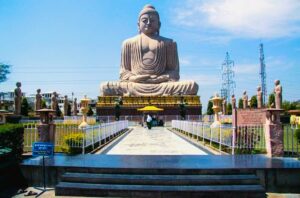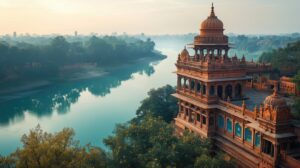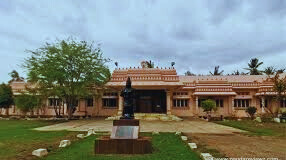
India is a land of contrasts, with a deep cultural historical past, diverse geography, and an electricity that captivates visitors. From bustling cities and tranquil countryside to deserts, beaches, mountains, and forests, India has something for each tourist. With a history stretching lower back heaps of years, India is an area in which historical traditions meet modern-day innovation, wherein colourful fairs and beautiful architectural wonders can be explored alongside breathtaking natural landscapes. This guide will help you navigate through India’s cultural, ancient, and natural attractions, supplying a comprehensive evaluate of what makes India an unforgettable travel vacation spot.
Table of Contents
ToggleIndia cultural and tourism attractions:
1. Indian tourism and cultural heritage
India is the definition of diversity. It has more than 2,000 ethnic groups, 1,600 dialects, and a rich cultural practice and tradition. This rich cultural heritage is showcased in the architecture. Religious sites, festivals, art, music, dance and food. The Indian tourism industry is divided into several main sectors:
- Cultural Tourism: Discover festivals, music, dance, art and food in many regions of India.
- Heritage Tourism: Relive India’s past through visits to forts, palaces and UNESCO World Heritage sites.
- Spiritual Tourism: Experience India’s religious diversity through pilgrimages, ashrams, and spiritual retreats.
- Natural Wildlife Tourism: Discover India’s unique landscapes, mountains, deserts, beaches, tropical forests.
- Adventure Tourism: India’s diverse terrain allows trekking, skiing, diving, and other adventure activities.
2. Top Cultural and Heritage Destinations in India
Every state in India offers a unique cultural experience. This makes it challenging to cover everything in one trip. But the main regions These capture the essence of India and provide an unforgettable experience.
a. The Golden Triangle (Delhi, Agra, Jaipur)
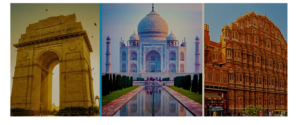
- Delhi: India’s capital is a mix of old and new. From the ancient Qutub Minar and the Red Fort to modern landmarks like the India Gate and the Lotus Temple, Chandni Chowk Market in Old Delhi is famous for its street food and shopping.
- Agra: Taj Mahal, one of the Seven Wonders of the World. It is the crown jewel of Agra. The city is home to the Agra Fort and the abandoned Mughal city of Fatehpur Sikri.
- Jaipur: Jaipur’s forts and palaces are known as the Pink City, such as the Hawa Mahal, Amber Fort and Nagar Palace. It showcases the greatness of Rajasthan’s rich heritage. Jaipur’s bustling bazaars are a great place to shop for traditional handicrafts and accessories.
b. Rajasthan: A Journey to India’s Royal Heritage
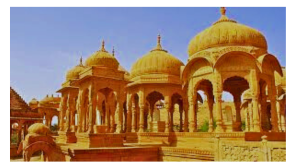
Rajasthan is a colorful state with magnificent palaces. Impressive fortress and a vibrant cultural heritage, Rajasthan’s cities offer a glimpse into India’s royal past.
- Udaipur: Lake City is famous for its Lake Palace and City Palace which are set against the backdrop of Lake Pichola. Udaipur’s serene beauty makes it a popular spot for a romantic getaway.
- Jodhpur: Nil Nagar is home to the Mehrangarh Fort, one of the largest forts in India. and the bustling markets of the old city
- Jaisalmer: Known as the Golden City. Jaisalmer is located in the heart of the Thar Desert. Highlights include the Jaisalmer Fort, made from yellow sandstone. and camel safaris in the desert
- Pushkar: A small town famous for Pushkar Lake, Brahma Temple and the annual camel show. Pushkar is also known for its serene atmosphere and attracts spiritual seekers from all over the world.
c. Kerala: God’s Own Country
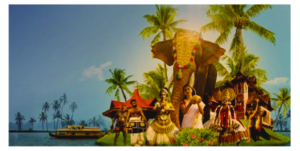
Kerala is famous for its calm waters. lush greenery and health tourism It is the perfect destination for travelers looking for convenience and natural beauty.
- Alleppey and Kumarakom: These towns are famous for boat trips through the beautiful waters of Kerala. Complete with coconut groves and traditional villages…
- Munnar – This hill station in the Western Ghats is surrounded by tea plantations, waterfalls and trekking trails. It’s the perfect place to escape the sweltering heat.
- Kochi: An ancient port city with Portuguese, Dutch and British influences. Attractions include Kochi Fort, Mattancherry Palace and traditional Katha Kali dance performances.
- Ayurvedic Retreats: Kerala is famous for Ayurveda, an ancient system of natural healing. Many resorts and wellness centers offer traditional treatments and treatments, making Kerala a top wellness destination.
d. Goa: The Land of Sun, Sand, and Sea
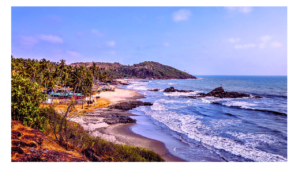
Goa is synonymous with beautiful beaches. Lively nightlife and Portuguese cultural heritage It is a great place for relaxation and adventure.
- Beaches: Goa has many beaches that cater to different senses. From the lively beaches of Baga and Calangute To the secluded beaches of Palolem and Agonda…
- Historic Churches: Goa’s Portuguese heritage can be found in the UNESCO-listed churches of Old Goa, including the Basilica of Bom-Jesus and the Basilica of Say…
- Nightlife: from beach huts to nightclubs Goa’s nightlife is popular with locals and tourists alike. It hosts music festivals like Sunburn, which attract electronic music lovers from around the world.
e. The Himalayan Region: Adventure, Nature, and Spirituality
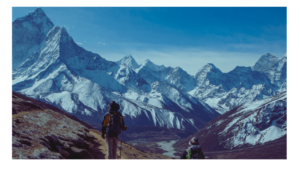
Northern India has the majestic Himalayas. Provide a spiritual experience exciting adventure And the most beautiful landscape in the country…
- Leh-Ladakh – High desert area famous for its monasteries. The scenery is spectacular, and lakes like Pangong Tso are hubs for hiking, rafting, and mountain biking.
- Rishikesh and Haridwar: Known as Known as the “Yoga Capital of the World”, Rishikesh is a popular yoga retreat and a popular destination for spiritual seekers. Haridwar is one of the holiest cities in Hinduism and hosts the world’s largest religious gathering, the Kumbh Mela.
- Shimla and Manali: These hill stations are popular for their cool climate. natural beauty and adventure activities such as skiing and paragliding…
3. Cultural Heritage and Festivals
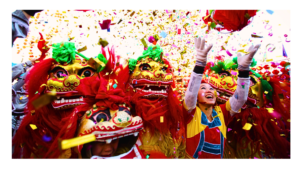
India’s cultural festivals and traditions are as diverse as they are diverse. with the landscape Each region has different festivals and celebrations.
a. Major Festivals of India
- Diwali: The festival of lights is celebrated across India with oil lamps, fireworks and festive sweets.
- Holi: Known as the festival of colours. Holi is celebrated in March with the festival of colour-throwing. which symbolizes the victory of good over evil.
- Navratri and Durga Puja: These festivals are especially popular in Gujarat and West Bengal. It celebrates the sacred feminine with music, dance and religious ceremonies…
- Eid: Celebrated by Muslims across India, Eid marks the end of Ramadan with feasts, prayers and celebrations.
- Christmas: Christian Community in India Especially in Kerala, Goa and the Northeast. Celebrate Christmas with a church ceremony. Festival food and local traditions…
b. Traditional Arts and Crafts
- Dance and Music: India has classical dance forms such as Bharatanatyam, Kathak and Odissi. Folk dances such as Bhangra (Punjabi) and Garba (Gujarati) are also popular. together
- Handicrafts: Indian artisans create unique handicrafts such as pashmina shawls. Madhubani painting earthenware and exquisite gems Each region has its own specialties, such as Rajasthani print pieces and Kanjeevara Maresh saris from Tamil Nadu.
4. Nature and Wildlife Tourism
India’s unique biodiversity makes it a prime destination for nature and wildlife lovers.
- National Parks: India has more than 100 national parks. Famous places include Ranthambore in Rajasthan, Kaziranga in Assam (home of the unicorn), and Jim Corbett in Uttarakhand, which is famous for its Bengal tigers.
- Hill Stations: India’s cool and lively hill stations like Darjeeling, Ooty and Nainital are famous for their tea gardens. Stunning scenery and a quiet atmosphere…
- Beaches and Islands: The Andaman and Nicobar Islands are famous for their coral reefs and water sports. Kovalam beaches in Kerala and Mahabalipuram. In the state of Tamil Nadu it is famous for its beautiful beaches and historical significance…
Exploring India: A Comprehensive Guide to Tourism and Cultural Heritage
India is a land of contrasts, with a deep cultural heritage, diverse geography, and an energy that captivates visitors. From bustling cities and tranquil countryside to deserts, beaches, mountains, and forests, India has something for every traveler. With a history stretching back thousands of years, India is a place where ancient traditions meet modern innovation, where vibrant festivals and stunning architectural wonders can be explored alongside breathtaking natural landscapes.
This guide will help you navigate through India’s cultural, historical, and natural attractions, providing a comprehensive overview of what makes India an unforgettable travel destination.
1. The Allure of Indian Culture and Tourism
India is defined by its diversity, with over 2,000 ethnic groups, 1,600 spoken languages, and a wealth of cultural practices and traditions. This rich cultural heritage is showcased in its architecture, religious sites, festivals, art, music, dance, and cuisine. India’s tourism industry is divided into several key areas:
- Cultural Tourism: Explore India’s festivals, music, dance, art, and cuisine across its many regions.
- Heritage Tourism: Relive India’s past through visits to forts, palaces, and UNESCO World Heritage Sites.
- Spiritual Tourism: Experience India’s rich religious diversity through pilgrimages, ashrams, and spiritual retreats.
- Nature and Wildlife Tourism: Discover India’s unique landscapes, from mountains and deserts to beaches and tropical forests.
- Adventure Tourism: India’s varied geography allows for trekking, skiing, diving, and other adventure activities.
2. Top Cultural and Heritage Destinations in India
Each state in India offers a unique cultural experience, making it challenging to cover everything in one trip. However, these key regions capture India’s essence and provide unforgettable experiences.
a. The Golden Triangle (Delhi, Agra, Jaipur)
The Golden Triangle is one of the most popular travel circuits in India, encompassing the cities of Delhi, Agra, and Jaipur. This route is perfect for travelers interested in India’s rich history and architecture.
- Delhi: India’s capital offers a blend of the old and new, from the ancient Qutub Minar and Red Fort to modern landmarks like India Gate and the Lotus Temple. Old Delhi’s Chandni Chowk market is famous for its street food and shopping.
- Agra: The Taj Mahal, one of the Seven Wonders of the World, is the crown jewel of Agra. This city also boasts Agra Fort and the abandoned Mughal city of Fatehpur Sikri.
- Jaipur: Known as the Pink City, Jaipur’s forts and palaces, like the Hawa Mahal, Amber Fort, and City Palace, showcase the grandeur of Rajasthan’s royal heritage. The bustling bazaars of Jaipur are ideal for picking up traditional handicrafts and jewelry.
b. Rajasthan: A Journey Through India’s Royal Heritage
Rajasthan is a colorful state with grand palaces, impressive forts, and a vibrant cultural heritage. The cities in Rajasthan give a glimpse of India’s regal past.
- Udaipur: The City of Lakes is known for the Lake Palace and the City Palace, set against the backdrop of Lake Pichola. Udaipur’s serene beauty makes it a favorite for romantic getaways.
- Jodhpur: The Blue City is home to Mehrangarh Fort, one of India’s largest forts, and the bustling bazaars of the old town.
- Jaisalmer: Known as the Golden City, Jaisalmer is located in the heart of the Thar Desert. The Jaisalmer Fort, made of yellow sandstone, and the desert camel safaris are major highlights.
- Pushkar: A small town famous for the Pushkar Lake, Brahma Temple, and its annual camel fair. Pushkar is also known for its peaceful atmosphere and attracts spiritual seekers from around the world.
c. Kerala: God’s Own Country
Kerala is known for its tranquil backwaters, lush greenery, and wellness tourism. It’s the perfect destination for travelers seeking relaxation and natural beauty.
- Alleppey and Kumarakom: These towns are famous for houseboat cruises through Kerala’s picturesque backwaters, lined with coconut groves and traditional villages.
- Munnar: This hill station in the Western Ghats is surrounded by tea plantations, waterfalls, and trekking trails. It’s an ideal spot to escape the tropical heat.
- Kochi: A historic port city with Portuguese, Dutch, and British influences. Attractions include Fort Kochi, Mattancherry Palace, and traditional Kathakali dance performances.
- Ayurvedic Retreats: Kerala is known for Ayurveda, an ancient system of natural healing. Many resorts and wellness centers offer traditional treatments and therapies, making Kerala a top wellness destination.
d. Goa: The Land of Sun, Sand, and Sea
Goa is synonymous with beautiful beaches, a vibrant nightlife, and Portuguese heritage. It’s the perfect spot for both relaxation and adventure.
- Beaches: Goa has a range of beaches catering to different vibes—from the lively beaches of Baga and Calangute to the serene shores of Palolem and Agonda.
- Historic Churches: Goa’s Portuguese heritage can be seen in the UNESCO-listed churches of Old Goa, including the Basilica of Bom Jesus and Se Cathedral.
- Nightlife: From beach shacks to nightclubs, Goa’s nightlife is popular with locals and tourists alike. It also hosts music festivals like Sunburn, drawing electronic music fans from around the world.
e. The Himalayan Region: Adventure, Nature, and Spirituality
The northern part of India is blessed with the majestic Himalayas, offering spiritual experiences, thrilling adventures, and some of the country’s most stunning landscapes.
- Leh-Ladakh: A high-altitude desert region known for its monasteries, scenic landscapes, and lakes like Pangong Tso. It’s a hub for trekking, river rafting, and mountain biking.
- Rishikesh and Haridwar: Known as the “Yoga Capital of the World,” Rishikesh offers yoga retreats and is a popular destination for spiritual seekers. Haridwar is one of Hinduism’s holiest cities and a site of the Kumbh Mela, the world’s largest religious gathering.
- Shimla and Manali: These hill stations are popular for their cool climate, natural beauty, and adventure activities such as skiing and paragliding.
3. Cultural Heritage and Festivals
India’s festivals and cultural traditions are as diverse as its landscapes, with each region offering its unique festivities and celebrations.
a. Major Festivals of India
- Diwali: The Festival of Lights is celebrated across India with oil lamps, fireworks, and festive sweets.
- Holi: Known as the Festival of Colors, Holi is celebrated with color-throwing festivities in March, symbolizing the victory of good over evil.
- Navratri and Durga Puja: These festivals, particularly popular in Gujarat and West Bengal, celebrate the divine feminine and are marked by music, dance, and religious rituals.
- Eid: Celebrated by Muslims across India, Eid marks the end of Ramadan with feasts, prayers, and celebrations.
- Christmas: India’s Christian communities, particularly in Kerala, Goa, and the northeast, celebrate Christmas with church services, festive meals, and local customs.
b. Traditional Arts and Crafts
- Dance and Music: India is home to classical dance forms like Bharatanatyam, Kathak, and Odissi. Folk dances such as Bhangra (Punjab) and Garba (Gujarat) are also popular.
- Handicrafts: Indian artisans produce unique handicrafts, including Pashmina shawls, Madhubani paintings, pottery, and intricate jewelry. Each region has its specialties, like Rajasthani block printing and Kanjeevaram silk sarees from Tamil Nadu.
4. Nature and Wildlife Tourism
India’s unique biodiversity makes it a prime location for nature and wildlife enthusiasts.
- National Parks: India has over 100 national parks. The most famous include Ranthambore in Rajasthan, Kaziranga in Assam (home to one-horned rhinos), and Jim Corbett in Uttarakhand, known for Bengal tigers.
- Hill Stations: The cool, refreshing hill stations of India, such as Darjeeling, Ooty, and Nainital, are famous for tea gardens, breathtaking views, and a peaceful environment.
- Beaches and Islands: The Andaman and Nicobar Islands are known for their coral reefs and water sports, while Kerala’s Kovalam Beach and Tamil Nadu’s Mahabalipuram are known for scenic beaches and historical significance.
5. Spiritual Tourism and Wellness
India’s spiritual heritage attracts travelers seeking peace and quiet. self discovery and well-being
- Yoga and meditation retreats: Rishikesh, Kerala and Auroville in Tamil Nadu are famous for their yoga centers, meditation retreats and wellness programs. Kerala is also known for Ayurveda, India’s traditional medical system.
- Pilgrimage Sites: Important pilgrimage sites include Varanasi, which is considered one of the holiest cities in Hinduism. Amritsar city with golden temple and Bodh Gaya, where the Buddha attained enlightenment.
6. Practical Travel Tips
- Best time to visit: Generally, October to March is the best time in most parts of India. But it’s best to visit the Himalayan region during the summer months. The monsoon season (June to September) can bring heavy rain in the south and northeast.
- Transportation: India has a well-connected rail network. Domestic flights and efficient public transportation in various cities, taxis, auto rickshaws And ride-sharing services are widely available for local travel.
- cultural etiquette: Respect local traditions by dressing modestly. Especially in rural areas and religious places. Always take off your shoes when entering temples and some houses.
Conclusion
Traveling to India is a journey through time, culture and tradition, with each visit. You will discover new aspects. of this land’s diverse and vibrant spiritual heritage. including a lively city ancient monument and breathtaking landscapes India is a country that is not only in your memory. But it also leaves a lasting impact. It enriches and transforms every traveler in different ways. They didn’t expect it.

